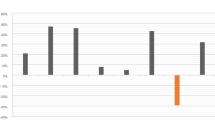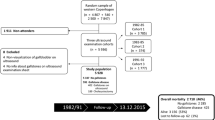Abstract
The aim of this study was to investigate the epidemiologic characteristics and changing patterns of gallstone disease in Korea over a recent 20-year period. A total of 4020 gallstone patients who had undergone surgery at Seoul National University Hospital during 1981–2000 were analyzed according to periods: period I (1981–1985: 831 cases); period II (1986–1990: 888 cases); period III (1991–1995: 1040 cases); period IV (1996–2000:1261 cases). The literature from 13 institutes in Korea reporting a total of 13,101 gallstone cases were reviewed to elucidate the nation-wide trend. The number of gallstone cases gradually increased. A female predominance was not noted (F/M = 1.17–1.37) as is seen in Western countries. The patients with common bile duct (CBD) stones were older than those with gallbladder (GB) stones or intrahepatic duct (IHD) stones. Over time, the relative proportion of those with a GB stone increased, plateauing (80–85%) during the 1990s; that of patients with CBD stones decreased (34% → 19%); and that of those with IHD stones remained unchanged (11–15%). Over the entire period, the rural pattern of gallstone formation (low number of GB stones, high numbers of CBD and IHD stones) has become similar to the urban pattern. The body mass index (BMI) of the GB stone group was above average, as were the BMIs of the CBD stone and IHD stone groups. Throughout the literature review, this same changing pattern of the relative proportion of gallstone disease was confirmed. Thus the pattern of gallstone disease in Korea has become similar to that seen in Western countries except for a high prevalence of hepatolithiasis.
Résumé
Le but de cette étude a été de déterminer les caractéristiques épidémiologiques et leurs éventuels aspects évolutifs de la maladie lithiasique en Corée pendant les 20 dernières années. On a analysé les dossiers de 4020 patients présentant une lithiase à l’Hôpital National Universitaire de Seoul (1981–2000) pendant plusieurs périodes différentes: période I 1981–1985:831 cas), période II (1986–1990:888 cas), période III (1991–1995:1040 cas) et période IV (1996–2000:1261 cas). La littérature provenant de 13 institutions en Corée rapportant 13101 cas de lithiase a été revue pour élucider la tendance nationale. Le nombre de cas de lithiase a augmenté. Comme dans les pays Occidentaux, on a noté une prédominance féminine (F/M = 1.17–137). Les patients ayant une lithiase de la voie biliaire principale (VBP) était plus âgés que les patients ayant une lithiase biliaire simple ou les patients ayant une lithiase intrahépatique (LIH). Avec le temps, la proportion relative de patients ayant une lithiase vésiculaire a augmenté pour atteindre un plateau (80–85%) dans les années 1990, la proportion de patients porteur de lithiase de la VBP a diminué (34% → 19%) et le groupe de patients porteurs de LIH est restée inchangée (11–15%). De même, le site de la lithiase (bas, haut, intrahépatique) dans la population rurale s’est rapproché de ce que l’on observe en ville. L’indexe de masse corporelle dans le groupe porteur de lithiase vésiculaire était plus élevé que la moyenne, et plus élevé que celui des patients porteur de lithiase de la VBP ou de LIH. A travers une revue de la littérature, cette même tendance s’est confirmée en ce qui concerne la proportion relative de patients porteurs de maladie lithiasique. Les tendances de la maladie lithiasique en Corée sont devenues similaires à celles des pays occidentaux sauf en ce qui concerne la prévalence élevée de lithiase intrahépatique.
Resumen
Investigar la evolución de las características epidemiológicas de la litiasis biliar a lo largo de los últimos 20 años en Corea. Se analizaron 4020 pacientes con litiasis biliar tratados quirúrgicamente en el Hospital Nacional Universitario de Seoul. Se dividieron, de acuerdo con diferentes periodos de tiempo: periodo I (1981–1985; n = 831), periodo II (1986–1990; n = 888) periodo III (1991–1995, n = 1,040) y periodo IV (1996–2000; n = 1,261). Además, se revisaron 13,101 casos de litiasis biliar de 13 Instituciones Hospitalarias de Corea, con objeto de averiguar la tendencia de esta enfermedad a escala nacional. La incidencia de la litiasis biliar se ha incrementando paulatinamente; sin embargo, no se constató una predominancia por el sexo femenino (M/V = 1.77–137) como ocurre en países occidentales. Los pacientes con coledocolitiasis (CBD) eran más viejos que los que aquejaban una colelitiasis (GB) o una hepatolitiasis (IHD). A lo largo del tiempo, los pacientes con GB aumentaron hasta alcanzar una meseta (80–85%) en los años noventa. La coledocolitiasis disminuyó (34% → 19%) y la hepatolitiasis no se modificó (11–15%). A lo largo de estos 20 años, las características de la litiasis biliar en zonas rurales (escasos casos de GB y muchos de CBD y IHD) se fue equiparando a los de las ciudades. El índice de masa corporal era superior en pacientes con GB que en los que presentaron una CBD o IHD. Nuestras observaciones coinciden con las referidas en la literatura mundial al respecto. Las características de la litiasis biliar en Corea son semejantes a las observadas en los países occidentales, excepto por lo que a la alta incidencia de hepatolitiasis (IHD) se refiere.
Similar content being viewed by others
References
Sarles H, Gerolami A, Cros RC. Diet and cholesterol gallstones. Digestion 1978;17:121–127
Sampliner RE, Bennett PH, Comess LJ, et al. Gallbladder disease in Pima Indians: demonstration of high prevalence and early onset by cholecystography. N. Engl. J. Med. 1970;283:1358–1364
Nervi F, Covarrubias C, Bravo P, et al. Influence of legume intake on biliary lipids and cholesterol saturation in young Chilean men: identification of a dietary risk factor for cholesterol gallstone formation in a highly prevalent area. Gastroenterology 1989;96:825–830
Sarles H, Chabert C, Pommeau Y, et al. Diet and cholesterol gallstones: a study of 101 patients with cholelithiasis compared to 101 matched controls. Am. J. Dig. Dis. 1969;14:531–537
Nakayama R, Miyake H. Changing state of gallstone disease in Japan: composition of the stones and treatment of the condition. Am. J. Surg. 1970;120:794–799
Su CH, Lui WY, Peng FK. Relative prevalence of gallstone diseases in Taiwan: a nationwide cooperative study. Dig. Dis. Sci. 1992;37:764–768
Kwon OJ, Park YH, Kim JP. A clinical study of cholelithiasis in Korea. J. Korean Surg. Soc. 1982;24:1052–1057
Park YH, Kim SW. Epidemiological and clinical characteristics of gallstone disease in Korea. J. Korean Surg. Soc. 1988;35:29–36
Kim SW, Park YH, Choi JW. Clinical and epidemiological analysis of 10-year experienced 1,719 gallstone patients. Korean J. Gastroenterol. 1993;25:159–167
Chang MC, Kim KW, Kim SW, et al. Clinical and epidemiological analysis of 15-year experience of 2,759 patients with gallstone. Korean J. Gastroenterol. 1998;31:100–106
Zhu X, Zhang S, Huang Z. The trend of the gallstone disease in China over the past decade. Chung. Hua Wai Ko Tsa Chih 1995;33:652–658
Nagase M, Hikasa Y, Soloway RD, et al. Gallstone in western Japan: factors affecting the prevalence of intrahepatic gallstones. Gastroenterology 1980;78:684–690
Seo CH, Lee KS. A clinical study of 100 cases of gallstone disease. J. Korean Surg. Soc. 1994;46:215–222
Han DR, Chang SK, Song YT, et al. Clinical analysis of gallstones in Korea. J. Korean Surg. Soc. 1988;34:564–574
Kim SJ, Lim HM, Chang IT, et al. Clinical analysis of biliary stone disease in Korea. J. Korean Surg. Soc. 1991;41:325–334
Kim JH, Cho BH, Kang NP. Surgical treatment of gallstones in Korea. J. Korean Surg. Soc. 1985;28:726–736
Shim CS, Lee JH, Ko SW, et al. Clinical observation of 204 cases of gallstone. Korean J. Intern. Med. 1984;27:1487–1493
Ko BG, Lee SG, Min PC. A clinical analysis of gallstones in Asan Medical Center for 2 years from 1989 to May 1991. J. Korean Surg. Soc. 1993;45:234–239
Kim BR, Sho EY. Characteristics and changes of gallstone in Korea. J. Korean Med. Assoc. 1988;31:23–29
Chung WM, Chung JH, Chung ID. A clinical study of gallstone disease. J. Korean Surg. Soc. 1988;38:209–216
Lee JH, Lee WJ, Choi DH. Clinical analysis of biliary stone. J. Korean Surg. Soc. 1996;51:266–272
Hahm JS, Lee OC, Park KK, et al. Changing state and present features of gallstone disease in Korea. Korean J. Intern. Med. 1994;47:485–492
Choo BH, Choi KW, Woo ZH, et al. A clinical review of biliary stones (256 cases). J. Korean Surg. Soc. 1994;46:959–968
Moon YM. Biliary stones in Korea. Korean J. Gastroenterol. 1987;19: 1–5
Chun WJ, Son JH. Clinical observations of cholelithiasis in Korea. J. Korean Surg. Soc. 1983;25:668–674
Kim SP, Kim JY, Cho HJ. Chronological changes of cholelithiasis in the southwestern part of Korea. J. Korea Surg. Soc. 1991;41:195–202
Muller JL. Diagnosis of cholelithiasis. Surg. Gynecol. Obstet. 1971;133: 774
Lee SY, Lee SK, Kim JW, et al. Clinical study on gallstone prevalence in general health screening people. Korean J. Intern. Med. 1994;47: 352–358
Jung HW, Kim YS, Kim MW, et al. Prevalence of gallstones in Korea. J. Korean Acad. Fam. Med. 1992;13:581–591
Wen CC, Lee HC. Intrahepatic stones: a clinical study. Ann. Surg. 1972; 175:166–177
Chiam HK, Unni PN, Hwang WS. Cholelithiasis in Singapore. II. A clinical study. Gut 1970;11:148–152
Kim S, Moon S, Popkin BM. The nutrition transition in South Korea. Am. J. Clin. Nutr. 2000;71:44–53
Choi SK, Park YH. Study for clonorchiasis. Korean J. Gastroenterol. 1986;18:503–510
Chidyllo SA, Cordone RP, Reader R, et al. Choledocholithiasis in Chinese immigrants with cholelithiasis. Surg. Gynecol. Obstet. 1991;172: 280–284
Nakeeb A, Comuzzie AG, Martin L, et al. Gallstones: genetics versus environment. Ann. Surg. 2002;235:842–849
Everson GT, McKinley C, Lawson M, et al. Gallbladder function in the human female: effect of the ovulatory cycle, pregnancy, and contraceptive steroids. Gastroenterology 1982;82:711–719
Ryan JP, Pellecchia D. Effect of ovarian hormone pretreatment on gallbladder motility in vitro. Life Sci. 1982;31:1445–1449
Bernstein RA, Giefer EE, Vieira JJ, et al. Gallbladder disease. II. Utilization of the life table method in obtaining clinically useful information: a study of 62,739 weight-conscious women. J. Chronic Dis. 1977; 30:529–541
Author information
Authors and Affiliations
Corresponding author
Rights and permissions
About this article
Cite this article
Park, Y.H., Park, S.J., Jang, J.Y. et al. Changing patterns of gallstone disease in Korea. World J. Surg. 28, 206–210 (2004). https://doi.org/10.1007/s00268-003-6879-x
Issue Date:
DOI: https://doi.org/10.1007/s00268-003-6879-x




